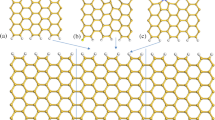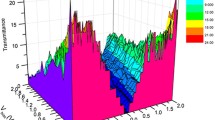Abstract
In this study, we investigated the electronic and thermoelectric properties of a pristine armchair-edge silicene nanoribbon (PASiNR) and armchair-edge silicene nanoribbons (ASiNRs) defected by quantum antidot arrays, called defective armchair edge silicene nanoribbons (DASiNRs). We considered DASiNRs in which quantum antidot arrays with rhomboid and hexagonal geometries were created. The results indicate that the creation of quantum antidot arrays has a significant impact on the electronic properties of ASiNRs, so the modified band structure leads to significant modifications in the current-voltage characteristic that shows a negative differential resistance at lower bias voltages. Furthermore, due to the modified electronic band structures and transmission spectra, we found that the Seebeck coefficient and the electronic figure of merit, and consequently the thermoelectric performance of DASiNRs, especially with asymmetric rhomboid-type structures, is much higher than the PASiNR. We use a tight-binding model and non-equilibrium Green's function formalism to obtain the electronic and thermoelectric properties. All numerical studies and simulations were performed using MATLAB codes.











Similar content being viewed by others
References
S. Venkateshalu, G. Subashini, P. Bhardwaj, G. Jacob, R. Sellappan, V. Raghavan, S. Jain, S. Pandiaraj, V. Natarajan, and B.A.M. Al Alwan, Phosphorene, antimonene, silicene and siloxene based novel 2D electrode materials for supercapacitors—a brief review. J. Energy Storage 48, 104027 (2022).
M. Ghosh and A. Datta, Pseudo-Jahn–Teller effects in two-dimensional silicene, germanene and stanene: a crystal orbital vibronic coupling density analysis. Bull. Mater. Sci. 41, 1 (2018).
F. Bechstedt, P. Gori, and O. Pulci, Beyond graphene: clean, hydrogenated and halogenated silicene, germanene, stanene, and plumbene. Prog. Surf. Sci. 96, 100615 (2021).
G.G. Naumis, Synthesis, Modeling, and Characterization of 2D Materials, and Their Heterostructures (Amsterdam: Elsevier, 2020).
M.A. Kharadi, G.F.A. Malik, F.A. Khanday, K.A. Shah, S. Mittal, and B.K. Kaushik, Silicene: from material to device applications. ECS J. Solid State Sci. Technol. 9, 115031 (2020).
Z. Meng, J. Zhuang, X. Xu, W. Hao, S.X. Dou, and Y. Du, Electronic band engineering in elemental 2D materials. Adv. Mater. Interfaces 5, 1800749 (2018).
A.H. Howlader, M.S. Islam, and N. Ferdous, Phonon transmission of vacancy disordered armchair silicene nanoribbon. OptoElectron. Lett. 17, 454 (2021).
S. Chowdhury and D. Jana, A theoretical review on electronic, magnetic and optical properties of silicene. Rep. Prog. Phys. 79, 126501 (2016).
Y.L. Song, Y. Zhang, J.M. Zhang, and D.B. Lu, Effects of the edge shape and the width on the structural and electronic properties of silicene nanoribbons. Appl. Surf. Sci. 256, 6313 (2010).
A.B. Chen, X.F. Wang, P. Vasilopoulos, M.X. Zhai, and Y.S. Liu, Spin-dependent ballistic transport properties and electronic structures of pristine and edge-doped zigzag silicene nanoribbons: large magnetoresistance. Phys. Chem. Chem. Phys. 16, 5113 (2014).
A. Kara, H. Enriquez, A.P. Seitsonen, L.L.Y. Voon, S. Vizzini, B. Aufray, and H. Oughaddou, A review on silicene—new candidate for electronics. Surf. Sci. Rep. 67, 1 (2012).
Y.Y. Wang, R.G. Quhe, D.P. Yu, and J. Lü, Silicene spintronics—a concise review. Chin. Phys. B 24, 087201 (2015).
Q. Guo, N. Chen, and L. Qu, Two-dimensional materials of group-IVA boosting the development of energy storage and conversion. Carbon Energy 2, 54 (2020).
A. Voznyakovskii, A. Neverovskaya, A. Vozniakovskii, and S. Kidalov, A quantitative chemical method for determining the surface concentration of stone-wales defects for 1D and 2D carbon nanomaterials. Nanomaterials 12, 5 (2022).
J. Yin, Y. Wang, L. Bi, S. Ren, G. Yan, X. Huang, and Z. Yang, Boron nitride nanoribbons with single vacancy defects and doped with 3d transition metals: a first-principles study. Mater. Today Commun. 26, 101861 (2021).
J. Haskins, A. Kınacı, C. Sevik, H. Sevinçli, G. Cuniberti, and T. Çağın, Control of thermal and electronic transport in defect-engineered graphene nanoribbons. ACS Nano 5, 3779 (2011).
K. Ma, X. Yan, Y. Xiao, and Y. Chen, Electronic transport properties of metallic graphene nanoribbons with two vacancies. Solid State Commun. 150, 1308 (2010).
M.W. Chuan, K.L. Wong, A. Hamzah, N.E. Alias, C.S. Lim, and M.L.P. Tan, Electronic properties of zigzag silicene nanoribbons with single vacancy defect. Indones. J. Electr. Eng. Comput. Sci. 19, 77 (2020).
P. Dutta, S.K. Maiti, and S. Karmakar, Positional dependence of energy gap on line defect in armchair graphene nanoribbons: two-terminal transport and related issues. J. Appl. Phys. 114, 034306 (2013).
F. Wan, X. Wang, Y. Guo, J. Zhang, Z. Wen, and Y. Li, Role of line defect in the bandgap and transport properties of silicene nanoribbons. Phys. Rev. B 104, 195413 (2021).
S. Mehdi Aghaei and I. Calizo, Band gap tuning of armchair silicene nanoribbons using periodic hexagonal holes. J. Appl. Phys. 118, 104304 (2015).
A. Samipour, D. Dideban, and H. Heidari, Impact of an antidote vacancy on the electronic and transport properties of germanene nanoribbons: a first principles study. J. Phys. Chem. Solids 138, 109289 (2020).
B. Shojaeverdi and E. Zaminpayma, Influence of vacancy cluster on the electronic transport properties of silicene sheet. Phys. E 121, 114109 (2020).
M. Rezaei, H. Karbaschi, M. Amini, M. Soltani, and G. Rashedi, Thermoelectric properties of armchair phosphorene nanoribbons in the presence of vacancy-induced impurity band. Nanotechnology 32, 375704 (2021).
P. Wei, W. Bao, Y. Pu, C.N. Lau, and J. Shi, Anomalous thermoelectric transport of Dirac particles in graphene. Phys. rev. lett. 102, 166808 (2009).
C. Núñez, M. Saiz-Bretín, P. Orellana, L. Rosales, and F. Domínguez-Adame, Tuning the thermoelectric response of silicene nanoribbons with vacancies. J. Phys.: Condens. Matter 32, 275301 (2020).
M. Barati, T. Vazifehshenas, T. Salavati-Fard, and M. Farmanbar, Phononic thermal conductivity in silicene: the role of vacancy defects and boundary scattering. J. Phys.: Condens. Matter 30, 155307 (2018).
Y. Yan, Q.F. Liang, H. Zhao, C.Q. Wu, and B. Li, Thermoelectric properties of one-dimensional graphene antidot arrays. Phys. Lett. A 376, 2425 (2012).
H. Sadeghi, S. Sangtarash, and C.J. Lambert, Enhancing the thermoelectric figure of merit in engineered graphene nanoribbons. Beilstein J. Nanotechnol. 6, 1176 (2015).
H. Sadeghi, S. Sangtarash, and C.J. Lambert, Enhanced thermoelectric efficiency of porous silicene nanoribbons. Sci. Rep. 6, 1176 (2015).
A. Darmawan, E. Suprayoga, A.R. Nugraha, and A.A. AlShaikhi, Thermoelectric properties of two-dimensional materials with combination of linear and nonlinear band structures. Mater. Today Commun. 33, 104596 (2022).
W. Liu, X. Shi, M. Hong, L. Yang, R. Moshwan, Z.G. Chen, and J. Zou, Ag doping induced abnormal lattice thermal conductivity in Cu 2 Se. J. Mater. Chem. C 6, 13225 (2018).
M.U. Sajid and H.M. Ali, Thermal conductivity of hybrid nanofluids: a critical review. Int. J. Heat Mass Transf. 126, 211 (2018).
X. Xu, J. Chen, J. Zhou, and B. Li, Thermal conductivity of polymers and their nanocomposites. Adv. Mater. 30, 1705544 (2018).
G. Xie, D. Ding, and G. Zhang, Phonon coherence and its effect on thermal conductivity of nanostructures. Adv. Phys.: X 3, 1480417 (2018).
P. Mishra, D. Singh, Y. Sonvane, and R. Ahuja, Two-dimensional boron monochalcogenide monolayer for thermoelectric material. Sustain. Energy Fuels 4, 2363 (2020).
R. Mondal, N.B. Singh, J. Deb, S. Mukherjee, and U. Sarkar, Electronic and transport property of two-dimensional boron phosphide sheet. J. Mol. Gr. Modell. 112, 108117 (2022).
H. Qi, Z. Sun, N. Wang, G. Qin, H. Zhang, and C. Shen, Two-dimensional Al2I2Se2: a promising anisotropic thermoelectric material. J. Alloys Compd. 876, 160191 (2021).
D. Li, Y. Gong, Y. Chen, J. Lin, Q. Khan, Y. Zhang, Y. Li, H. Zhang, and H. Xie, Recent progress of two-dimensional thermoelectric materials. Nano-Micro Lett. 12, 1 (2020).
Z.T. Esfahani, A. Saffarzadeh, and A. Akhound, A DFT study on the electronic and magnetic properties of triangular graphene antidot lattices. Eur. Phys. J. B 91, 1 (2018).
Z. Jokar and M.R. Moslemi, Effects of position and shape of atomic defects on the band gap of graphene nano ribbon superlattices. Int. J. Electron. Commun. Eng. 9, 162 (2015).
A. Samipour, D. Dideban, and H. Heidari, Impact of substitutional metallic dopants on the physical and electronic properties of germanene nanoribbons: a first principles study. Results Phys. 18, 103333 (2020).
R. Chegel and M. Hasani, Electronic and thermal properties of silicene nanoribbons: third nearest neighbor tight binding approximation. Chem. Phys. Lett. 761, 138061 (2020).
X. Chen, Z. Shi, B. Chen, S. Xiang, and G. Zhou, Sensitivity of helical edge states to line substitutional magnetic doping in zigzag silicene nanoribbons. Solid State Commun. 254, 42 (2017).
Y. Pei and H.B. Wu, Optimized geometry and electronic structure of graphyne-like silicyne nanoribbons. Chin. Phys. B 22, 057303 (2013).
T.N. Todorov, Tight-binding simulation of current-carrying nanostructures. J. Phys.: Condens. Matter 14, 3049 (2002).
V.T. Tran, J. Saint-Martin, P. Dollfus, and S. Volz, Third nearest neighbor parameterized tight binding model for graphene nano-ribbons. AIP Adv. 7, 075212 (2017).
G. Klimeck and T. Boykin, Springer Handbook of Semiconductor Devices (Berlin: Springer, 2022).
L. Zhang, Symmetric and antisymmetric electric fields induced spin valves in a zigzag silicene nanoribbon ferromagnetic junction. J. Phys.: Condens. Matter 31, 495302 (2019).
E. Schrodinger, An undulatory theory of the mechanics of atoms and molecules. Phys. Rev. 28, 1049 (1926).
K. Wong, M. Chuan, W. Chong, N. Alias, A. Hamzah, C. Lim, and M. Tan, Modeling of low-dimensional pristine and vacancy incorporated graphene nanoribbons using tight binding model and their electronic structures. Adv. Nano Res. 7, 209 (2019).
S.S. Datta, Electronic Transport in Mesoscopic Systems (Cambridge: Cambridge University Press, 1997).
M.L. Sancho, J.L. Sancho, J.L. Sancho, and J. Rubio, Highly convergent schemes for the calculation of bulk and surface Green functions. J. Phys. F: Met. Phys. 15, 851 (1985).
K. Yang, S. Cahangirov, A. Cantarero, A. Rubio, and R. D’Agosta, Thermoelectric properties of atomically thin silicene and germanene nanostructures. Phys. Rev. B 89, 125403 (2014).
U. Sivan and Y. Imry, Multichannel Landauer formula for thermoelectric transport with application to thermopower near the mobility edge. Phys. Rev. B 33, 551 (1986).
L. Rosales, M. Pacheco, Z. Barticevic, A. León, A. Latgé, and P. Orellana, Transport properties of antidot superlattices of graphene nanoribbons. Phys. Rev. B 80, 073402 (2009).
X. Li, D. Zou, B. Cui, C. Fang, J. Zhao, D. Li, and D. Liu, Edge hydrogenation-induced spin-filtering and negative differential resistance effects in zigzag silicene nanoribbons with line defects. RSC Adv. 7, 25244 (2017).
R.L. An, X.F. Wang, P. Vasilopoulos, Y.S. Liu, A.B. Chen, Y.J. Dong, and M.X. Zhai, Vacancy effects on electric and thermoelectric properties of zigzag silicene nanoribbons. J. Phys. Chem. C 118, 21339 (2014).
Z. Gholami and F. Khoeini, Pure thermal spin current and perfect spin-filtering with negative differential thermoelectric resistance induced by proximity effect in graphene/silicene junctions. Sci. Rep. 11, 104 (2021).
Z. Gholami and F. Khoeini, Vacancy tuned thermoelectric properties and high spin filtering performance in graphene/silicene heterostructures. Sci. Rep. 11, 15320 (2021).
L. Pan, H. Liu, X. Tan, H. Lv, J. Shi, X. Tang, and G. Zheng, Thermoelectric properties of armchair and zigzag silicene nanoribbons. Phys. Chem. Chem. Phys. 14, 13588 (2012).
Author information
Authors and Affiliations
Corresponding author
Ethics declarations
Conflict of interest
The authors declare that they have no conflict of interest.
Additional information
Publisher's Note
Springer Nature remains neutral with regard to jurisdictional claims in published maps and institutional affiliations.
Rights and permissions
Springer Nature or its licensor (e.g. a society or other partner) holds exclusive rights to this article under a publishing agreement with the author(s) or other rightsholder(s); author self-archiving of the accepted manuscript version of this article is solely governed by the terms of such publishing agreement and applicable law.
About this article
Cite this article
Kalami, R., Ketabi, S.A. Electronic and Thermoelectric Properties of Armchair-Edge Silicene Nanoribbons: Role of Quantum Antidot Arrays. J. Electron. Mater. 52, 6566–6577 (2023). https://doi.org/10.1007/s11664-023-10578-5
Received:
Accepted:
Published:
Issue Date:
DOI: https://doi.org/10.1007/s11664-023-10578-5




